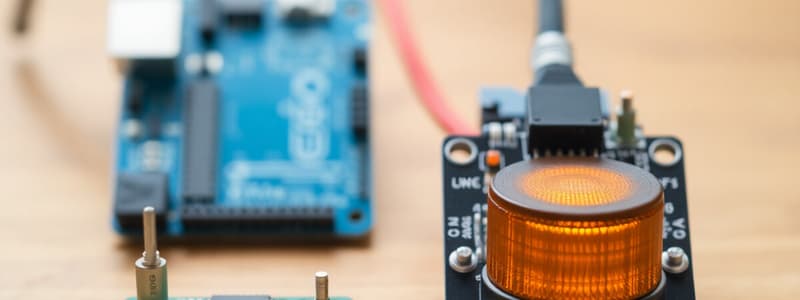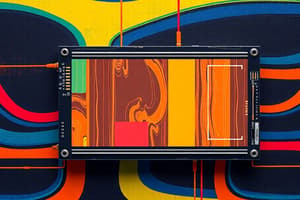Podcast
Questions and Answers
What type of sensor output allows for a range of measurements rather than a simple ON/OFF condition?
What type of sensor output allows for a range of measurements rather than a simple ON/OFF condition?
Which sensor is primarily used in motion detection applications?
Which sensor is primarily used in motion detection applications?
How many pins does an IR sensor typically have?
How many pins does an IR sensor typically have?
What kind of signal do digital pins provide on the Arduino up to?
What kind of signal do digital pins provide on the Arduino up to?
Signup and view all the answers
What range of distance can an ultrasonic sensor measure?
What range of distance can an ultrasonic sensor measure?
Signup and view all the answers
What is the purpose of the IR receiver in the context of remote control?
What is the purpose of the IR receiver in the context of remote control?
Signup and view all the answers
What is the primary function of a photoresistor?
What is the primary function of a photoresistor?
Signup and view all the answers
What type of electrical component is a potentiometer?
What type of electrical component is a potentiometer?
Signup and view all the answers
In what type of projects would a BME280 sensor be particularly useful?
In what type of projects would a BME280 sensor be particularly useful?
Signup and view all the answers
Which sensor is best suited for detecting water levels or leaks?
Which sensor is best suited for detecting water levels or leaks?
Signup and view all the answers
Study Notes
Arduino UNO Sensors
-
Learning Objectives:
- Define "sensor"
- Differentiate analog and digital input pins
- Identify various sensor types
- Explain sensor function and applications
What is a Sensor?
- A sensor detects, measures, records, indicates, or responds to physical properties.
- It converts physical actions into electrical equivalents.
- This conversion allows for easier processing and transmission of data.
- Sensors can provide binary (present/absent) or analog (numerical value) outputs.
Difference Between Analog and Digital Sensors
-
Analog sensors provide readings across a range of values (continuous).
-
The Arduino's analog-to-digital converter (ADC) allows for precise analog measurements.
-
Digital sensors deliver a binary output (high/low).
-
Digital sensors provide a straightforward on/off state.
Sensors for Arduino
-
Ultrasonic Sensor: Measures distances using ultrasonic sound waves.
- Range: 2cm to 500cm (0.78in to 196in).
-
IR Sensor: A radiation-sensitive component detecting infrared light.
- Used in motion detectors and alarm systems.
- Infrared light is in range 780 nm to 50µm.
- IR Receiver: Receives infrared signals, often used for remote controls.
-
Photoresistor (LDR): Measures brightness; a light-dependent resistor.
- Determines darkness/light conditions
- Requires a voltage divider and a resistor (10kΩ).
-
Temperature Sensor (TMP36): Measures temperature in Celsius.
- Output is a voltage linearly proportional to temperature
- Range: -40°C to +125°C (accuracies of ±1°C at +25°C and ±2°C).
-
Potentiometer: A variable resistor with a sliding contact for adjusting a voltage.
- Control brightness of an LED or motor speed.
- Reading is provided by ADC on Arduino.
-
Alcohol Gas Sensor (MQ-3): Detects and measures alcohol gas.
- Detects alcohol, ethanol
- Range: 10 to 1000 ppm
Other Useful Sensors
- Water Sensor: Detects water levels or leaks. Converts water level to an analog signal.
- Line Tracking Sensor: Guides robots along a line (often white on a dark background.)
- Methane Gas Sensor: Detects methane, propane, hydrogen, and related gases.
- 2.4 GHz Wireless Transceiver: Connects devices wirelessly (e.g., home automation.)
- Color Sensor: Measures light intensity of specific colors and outputs a signal accordingly. Often used for sorting objects by color.
Studying That Suits You
Use AI to generate personalized quizzes and flashcards to suit your learning preferences.
Related Documents
Description
This quiz covers the basics of sensors in the context of Arduino UNO. You'll learn to define sensors, differentiate between analog and digital inputs, and identify various sensor types along with their functions and applications. Perfect for beginners looking to understand sensor technology.




